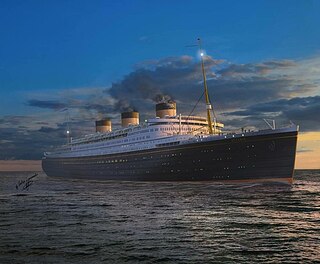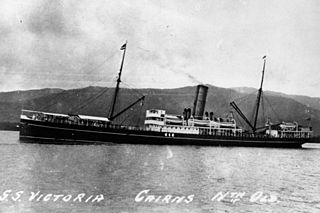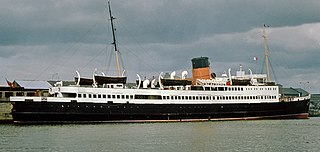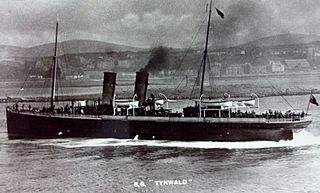
Royal Mail Ship, usually seen in its abbreviated form RMS, is the ship prefix used for seagoing vessels that carry mail under contract to the British Royal Mail. The designation dates back to 1840. Any vessel designated as "RMS" has the right both to fly the pennant of the Royal Mail when sailing and to include the Royal Mail "crown" insignia with any identifying device and/or design for the ship.

Oceanic was the planned name of an unfinished ocean liner that was partially built by Harland and Wolff for the White Star Line. It would have been the third ship bearing the name Oceanic, after the one of 1870 and the one of 1899. It was envisaged in 1926, with the idea of modernizing the transatlantic service of the company. With the arrival of Lord Kylsant at the head of the company, the planned size of the project increased, until it became that of a large ship destined to be the first to exceed the symbolic limit of 1,000 feet (305 m) in length and 30 knots in speed.

RMS Arlanza was a 14,622 GRT ocean liner of the Royal Mail Steam Packet Company. She was built in Belfast in 1912 for RMSP's scheduled route between England and South America. She was a Royal Navy armed merchant cruiser from 1915 until 1920. She returned to civilian liner service in 1920 and was scrapped in 1938.

RMS Alcantara was a Royal Mail Lines ocean liner that was built in Belfast in 1926. She served in the Second World War first as an armed merchant cruiser and then a troop ship. She returned to civilian service in 1948 and was scrapped in 1958.

The Union-Castle Line was a British shipping line that operated a fleet of passenger liners and cargo ships between Europe and Africa from 1900 to 1977. It was formed from the merger of the Union Line and Castle Shipping Line.
Alcantara, Alcântara (Portuguese), Alcántara (Spanish), Alcàntara, Alcàntera, El-Qantarah and (El) Kantara are all transliterations of the Arabic word al-qantara (القنطرة), meaning "the bridge".

The first USS Gettysburg was a steamer in the United States Navy. The ship was built in Glasgow, Scotland, in 1858, named RMS Douglas, and operated by the Isle of Man Steam Packet Company in the United Kingdom between Liverpool, England, and Douglas on the Isle of Man until November 1862. She was then sold to Cunard, Wilson & Company on behalf of the Confederate agents Fraser, Trenholm & Company for use by the Confederate States of America during the American Civil War. Renamed Margaret and Jessie, she operated as a blockade runner until her capture by the Union on 5 November 1863. The ship then was commissioned into the Union Navy on 2 May 1864 as USS Gettysburg.

RMS Arundel Castle was a British ocean liner and Royal Mail Ship which entered service in 1921 for the Union-Castle Line. A previous vessel of the same name was built in 1864 by Donald Currie & Co. and sold in 1883, whereupon it was renamed Chittagong. Originally laid down as the Amroth Castle in 1915, building was delayed by the First World War. She was eventually launched on 11 September 1919. She was completed on 8 April 1921 and in 22 April 1921 the ship departed from Southampton on her maiden voyage to Cape Town. During World War 2 she was requisitioned by the Admiralty to serve as a troopship. After the war she resumed passenger service, eventually being scrapped in 1959.

The Pacific Steam Navigation Company was a British commercial shipping company that operated along the Pacific coast of South America, and was the first to use steam ships for commercial traffic in the Pacific Ocean.

TSS Manxman was a passenger ferry launched from the Cammell Laird shipyard, Birkenhead, on 8 February 1955. She was the final vessel in a class of six similar ships, the Six Sisters, ordered by the Isle of Man Steam Packet Company, and was the second of the Company's ships to carry this name. She was withdrawn from service in 1982. Following a failed preservation attempt, and featuring in a music video in the process, the ship was broken up at Sunderland in 2012.

The Royal Mail Steam Packet Company was a British shipping company founded in London in 1839 by a Scot, James MacQueen. The line's motto was Per Mare Ubique. After a troubled start, it became the largest shipping group in the world in 1927 when it took over the White Star Line. The company was liquidated and its assets taken over by the newly formed Royal Mail Lines in 1932 after financial trouble and scandal; over the years RML declined to no more than the name of a service run by former rival Hamburg Süd.
RMS Amazon may refer to one of the following Royal Mail Ships of the Royal Mail Steam Packet Company or Royal Mail Lines:

The Britannia class was the Cunard Line's initial fleet of wooden paddlers that established the first year round scheduled Atlantic steamship service in 1840. By 1845, steamships carried half of the transatlantic saloon passengers and Cunard dominated this trade. While the units of the Britannia class were solid performers, they were not superior to many of the other steamers being placed on the Atlantic at that time. What made the Britannia class successful is that it was the first homogeneous class of transatlantic steamships to provide a frequent and uniform service. Britannia, Acadia and Caledonia entered service in 1840 and Columbia in 1841 enabling Cunard to provide the dependable schedule of sailings required under his mail contracts with the Admiralty. It was these mail contracts that enabled Cunard to survive when all of his early competitors failed.

SS Albertic was a British ocean liner, originally built as the Norddeutscher Lloyd's München. It was handed to Britain as part of war reparations and served during the 1920s and 1930s.

SS (RMS) Tynwald (III), No. 95755, was an iron passenger steamer which served with the Isle of Man Steam Packet Company, and was the third vessel in the Company to bear the name.

RMS Otranto was an ocean liner that was built for the Orient Steam Navigation Company in 1925. The "RMS" prefix stands for Royal Mail Ship, as she carried overseas mail under a contract between Orient Line and Royal Mail. Otranto was in service until 1957, when she was sold for scrap.

RMS Asturias was a Royal Mail Steam Packet Company ocean liner that was built in Ireland in 1908 and scrapped in Japan in 1933. She was a Royal Mail Ship until 1914, when on the eve of the First World War the British Admiralty requisitioned her as a hospital ship.

RMS Asturias was a Royal Mail Lines ocean liner that was built in Belfast in 1925. She served in the Second World War as an armed merchant cruiser until she was crippled by a torpedo in 1943. She was out of action until 1948 when she returned to civilian service as an emigrant ship. She became a troop ship in 1954 and was scrapped in 1957.
RMS Orinoco was a British Royal Mail Ship that was built in Scotland in 1886 and scrapped, also in Scotland, in 1909. She spent her entire career with the Royal Mail Steam Packet Company (RMSP), mainly trading between England and the Caribbean.















